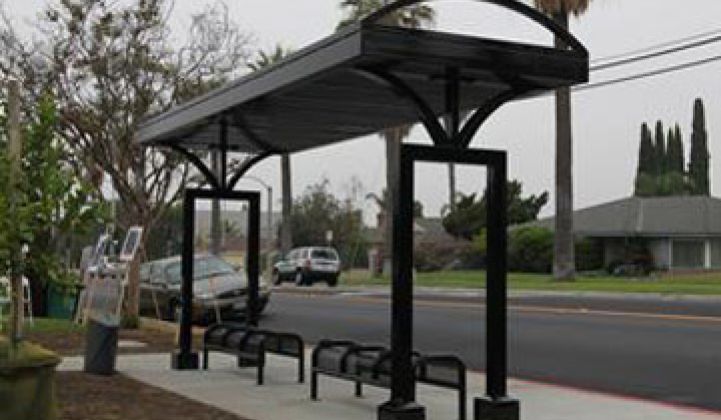GoGreenSolar is bringing solar to the the rooftops of bus shelters and using that power to tie into the grid. The shelter doubles as both a place of shade for transit customers, as well as a mini-power generation plant.
I spoke with Deep Patel, the CEO of GoGreenSolar, about deploying solar in this novel location.
A recent installation in Corona, California marked the first grid-connected solar system for bus shelters. According to Patel, solar-powered bus stops are becoming more common, but they are usually off-grid units which store the energy required to light the shelter in batteries. This new system is connected to the grid, and since it's more than one kilowatt of total power, it's eligible for the California Solar Initiative rebate as well as the federal tax grant program.
Interestingly, a lot of leading technology is being brought to bear on this seemingly mundane application, including high efficiency panels from Sanyo, microinverters from Enphase and LED lighting fixtures -- six panels and six inverters per shelter for a total of about 1.2 kilowatts of power. According to Patel, "The only practical way to go in this application is with microinverters," because of the size issues of a central inverter and the safety issues offered by lower voltage microinverters.
A traditional bus stop costs anywhere from $10,000 to $12,000. The GoGreenSolar shelters costs about $14,500, but once the incentives are factored in, the solar structure costs about the same as the traditional bus shelter without solar. It would seem like a no-brainer decision.
GoGreenSolar was responsible for supplying the solar hardware, electrical components and connecting the solar bus stop to the city's local area network (the city can remotely monitor how much energy the bus stop is generating). Solade designed the steel structure, permitted and constructed the project.
The customer for the Corona unit was the municipality itself. But customers for solar on-grid bus shelters are not limited to municipalities as bus shelters are sometimes owned by transit agencies or private advertisement companies.
For the the City of Corona, the solar shelter essentially wipes out the electrical cost of the intersection -- at least in the summer. According to Patel, Corona is actually making money from the shelter, saying, "It's gone from a cost to an asset."
This product is becoming a big part of GoGreenSolar's business. According to Patel, this idea is "gaining traction." The firm "has proposals on deck with media companies."
He asserts, "It's microgeneration -- distributed generation at the micro level and a huge opportunity to generate power in our community."



